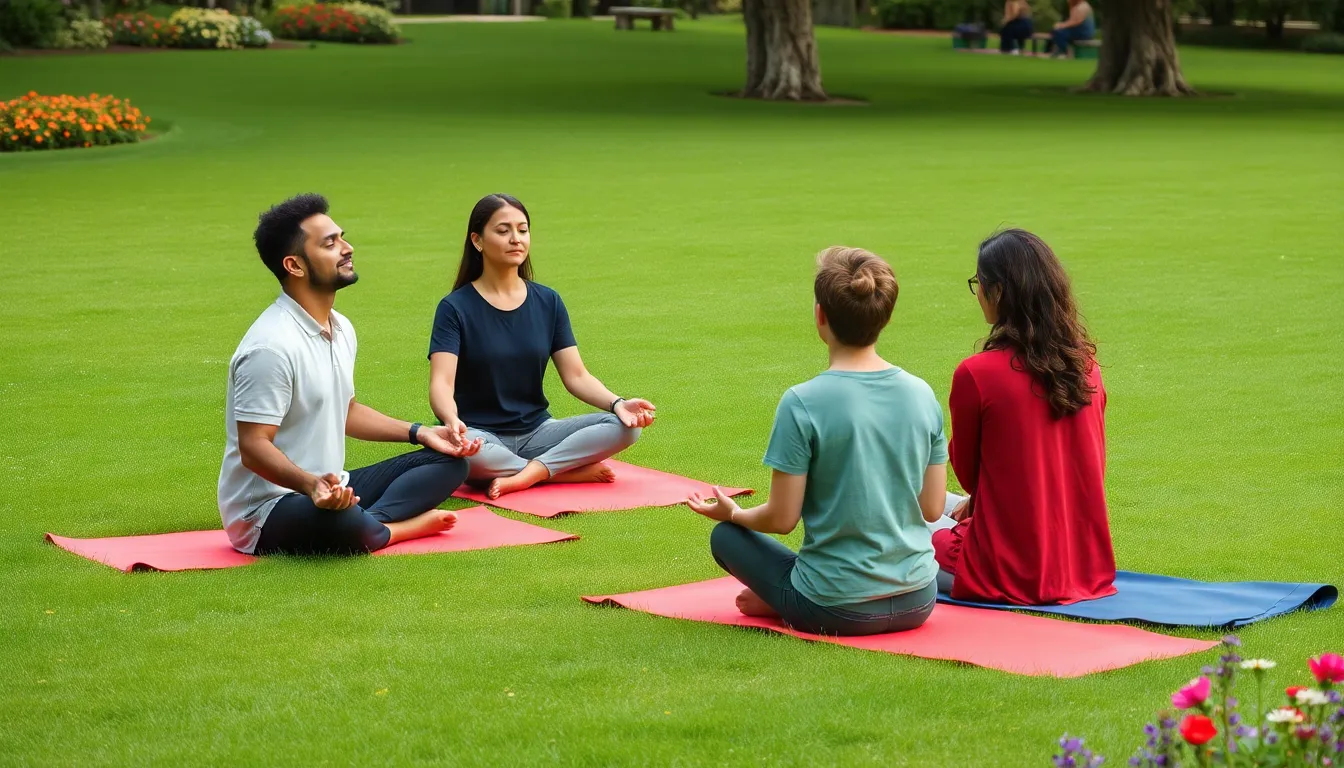In today’s fast-paced world, finding a moment of peace can feel like searching for a unicorn in a haystack. But what if a little mindfulness could transform your group’s energy from chaotic to calm? Enter mindfulness exercises—your ticket to a zen-like atmosphere where stress takes a backseat and focus takes the wheel.
Mindfulness Exercises for Groups PDF
Mindfulness involves a mental state achieved by focusing on the present moment, acknowledging one’s feelings, thoughts, and bodily sensations non-judgmentally. This practice fosters awareness and can significantly improve emotional well-being. Incorporating mindfulness into group activities enhances participants’ concentration while reducing stress.
Group mindfulness exercises often include techniques such as breathing practices, body scans, and guided imagery. Breathing exercises can effectively center a group, offering a moment to pause and reset. Body scans encourage individuals to tune into physical sensations, promoting relaxation. Guided imagery utilizes visualization techniques, allowing participants to explore calming mental landscapes.
Regular engagement with mindfulness leads to numerous benefits, both personally and collectively. Individuals report increased emotional regulation and resilience, while groups experience improved communication and collaboration. Implementing these exercises consistently can transform the dynamics within a group, creating a supportive and focused environment.
Research supports that practicing mindfulness can reduce anxiety levels in both individuals and communities. A study published in the Journal of Psychological Science noted a 30% decrease in reported anxiety among participants engaged in mindfulness practices over an eight-week period. As groups practice mindfulness together, they build trust and open lines of communication, essential components for effective teamwork.
Mindfulness serves as a practical tool for enhancing group interactions and fostering a peaceful atmosphere. The positive impacts extend beyond individual experiences, influencing overall group cohesion and productivity. Such practices nurture a culture of mindfulness, ultimately transforming group dynamics.
Benefits of Mindfulness Exercises for Groups

Mindfulness exercises yield significant advantages for groups, enhancing overall well-being and collaboration. Participants in these exercises enjoy multiple benefits that contribute to a harmonious group environment.
Enhancing Group Dynamics
Engaging in mindfulness practices together strengthens group cohesion. Trust builds as members share their experiences, leading to deeper connections. Active listening improves, allowing individuals to feel heard and valued. Communication skills sharpen, facilitating open dialogues and reducing misunderstandings. Conflict resolution becomes smoother, as mindfulness encourages a focus on the present rather than past grievances. Groups often find that these enhanced dynamics support a collaborative atmosphere, promoting productivity and creativity.
Reducing Stress and Anxiety
Mindfulness exercises effectively lower stress levels for group members. Participants experience a calming effect, which can diminish feelings of overwhelm. Studies show that consistent practice reduces anxiety, resulting in a more relaxed environment. Individuals develop greater emotional regulation, learning to manage stressors more effectively. As anxiety diminishes, focus improves, allowing group activities to proceed with greater clarity. Groups that prioritize mindfulness can cultivate a supportive setting that not only benefits individuals but also enhances overall group performance.
Types of Mindfulness Exercises
Mindfulness exercises can vary significantly, catering to different group needs and preferences. Key types include breathing techniques, guided meditation, and body scans, each offering unique benefits.
Breathing Techniques
Breathing techniques focus on the breath as a foundation for mindfulness. Practicing deep, intentional breathing calms the nervous system and promotes relaxation. Participants might practice exercises such as diaphragmatic breathing, where they inhale deeply through the nose and exhale slowly through the mouth. Incorporating this method enhances attention and reduces anxiety within group settings. Many individuals find that synchronizing breath with a group fosters a deeper sense of connection, creating a supportive atmosphere.
Guided Meditation
Guided meditation involves a facilitator leading participants through a meditation session. The facilitator typically shares calming imagery or focuses on specific themes, such as gratitude or compassion. This exercise encourages participants to visualize serene landscapes or positive experiences, promoting mental relaxation and emotional clarity. Groups practicing guided meditation often report enhanced focus and reduced stress levels, fostering an environment conducive to collaboration. Participants can experience a collective sense of calmness, strengthening group dynamics.
Body Scan
Body scan exercises direct attention to different body parts, fostering increased awareness of physical sensations. Typically conducted while lying down, participants mentally scan their bodies from head to toe. This method provides insights into how stress manifests physically, allowing individuals to acknowledge and release tension. Engaging in body scans as a group builds empathy and understanding while promoting relaxation. Individuals often leave these sessions feeling rejuvenated, with enhanced emotional stability and team cohesion.
How to Implement Mindfulness Exercises in Groups
Implementing mindfulness exercises in groups requires careful planning and attention to the setting. The right environment significantly impacts the effectiveness of these practices.
Setting Up the Environment
Choose a quiet space to minimize distractions during mindfulness sessions. Ensure the area has comfortable seating arrangements that encourage relaxation. Soft lighting fosters a calm atmosphere, while natural elements like plants improve overall ambiance. Maintain a temperature that feels comfortable for all participants. Consider using calming scents from essential oils or diffusers to enhance the sensory experience. Arranging cushions or mats on the floor can also provide flexibility in seating options and encourage a casual yet focused environment.
Facilitating Sessions
Begin each session with a brief introduction to the mindfulness exercise. Clearly explain its purpose to all participants, fostering engagement and understanding. Encourage everyone to focus on their breath to ground themselves. Guide them through the practice step-by-step, using a calm and soothing voice. Regularly check in with the group, inviting them to share experiences if they feel comfortable. Observing participants’ body language and adapting the pace ensures the session meets the group’s needs. End each session with a moment of silence, allowing participants to reflect on their experience and reinforce mindfulness in daily life.
Accessibility of Mindfulness Exercises for Groups PDF
Mindfulness exercises for groups often come in PDF formats, making them easily accessible. Digital files allow numerous participants to download and utilize resources at their convenience. Ensuring the availability of such documents online promotes a wider reach, enabling organizations to disseminate mindfulness practices effectively.
A variety of platforms provide free or low-cost access to mindfulness exercises tailored for groups. Websites like Mindful.org and Calm offer downloadable resources that facilitate guided sessions. Accessing these resources supports consistency in practice during group activities.
PDF documents also support interactive elements, such as fillable fields for notes or reflections. Utilizing these features encourages participants to engage actively with the exercises, enhancing their experience and understanding. Visual aids within the PDFs, like diagrams or illustrations, can simplify instructions and provide clear guidance.
Accessibility ensures that diverse groups can benefit from mindfulness practices, regardless of experience levels. Various adaptations make it simple for facilitators to adjust the exercises according to participants’ needs. Incorporating accessibility features, like alt text for images or large print formats, accommodates individuals with different learning styles or physical limitations.
Availability of resources online also promotes ongoing practice outside of group settings. Participants can revisit PDFs anytime, reinforcing what they learned during sessions. This aspect fosters personal growth and mindfulness skills application in daily life. Thus, creating a supportive environment where all group members thrive becomes easier.
Conclusion
Incorporating mindfulness exercises into group settings can significantly enhance emotional well-being and foster a supportive atmosphere. As participants engage in practices like breathing techniques and guided meditations, they cultivate a sense of calm and focus that benefits the entire group.
Utilizing accessible resources such as PDFs makes it easier for groups to implement these exercises consistently. This commitment to mindfulness not only improves individual resilience but also strengthens group dynamics, leading to better communication and collaboration. By embracing mindfulness, groups can transform their environments into spaces of trust and productivity, ultimately paving the way for lasting positive change.

